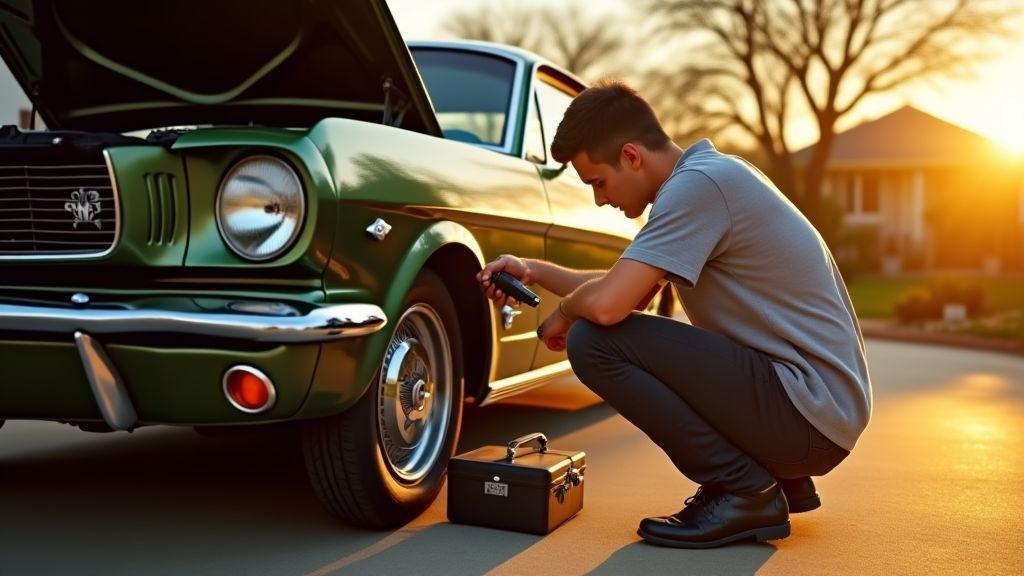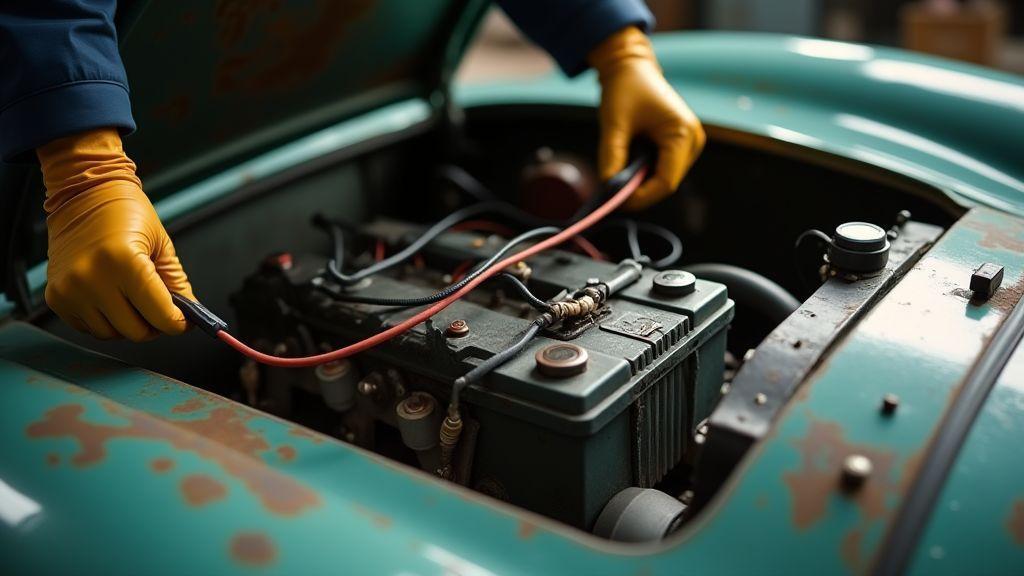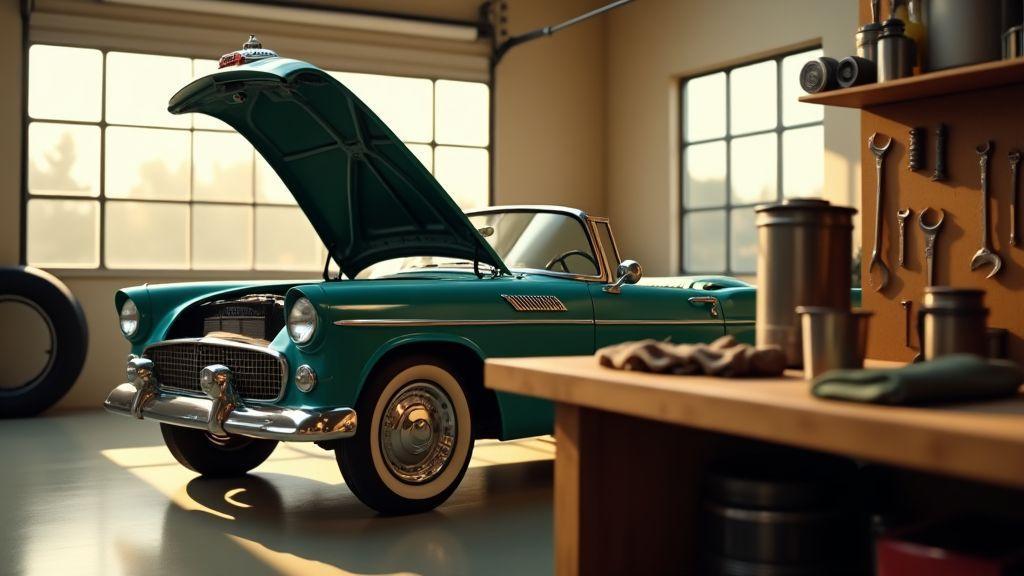Classic Car Maintenance Checklist — Keep It Running Smooth gives you a quick, easy intro to the checks that keep your vintage ride reliable. You get fast tips for pre-drive checks, tires, brakes, oil, belts, battery, and fluids. It also covers seasonal care and simple DIY tips to save time and avoid breakdowns. Keep it short. Keep it steady.
Key Takeaway
- Check and change your oil and brake fluid regularly
- Run your car often to keep parts lubricated
- Check your tires and brakes for wear and proper pressure
- Clean and wax your car to prevent rust
- Store your car in a dry place and keep the battery charged

Quick Pre-Drive Classic Car Maintenance Checklist — Keep It Running Smooth
Think of this checklist as a quick warm-up for your classic. You give it five minutes and it pays you back with a smoother drive and fewer surprises. A short routine stops little problems from turning into roadside dramas.
Start with the big, easy wins: fluid levels, battery clamps, lights, belts and a look at the tires. Do a fast under‑hood glance and a slow walk around the car. These steps keep your ride reliable and your confidence high. For a concise reference, see the Five-minute pre-drive car check routine.
Make it a habit before every run, whether it’s a short errand or a weekend cruise. You’ll feel proud when the engine purrs and the brakes bite like they should.
Use a classic car inspection checklist for pre-drive checks
A written checklist keeps you honest and helps you move fast. Put a small list in the glovebox or save a note on your phone. Follow the items in the same order each time so you don’t skip the odd little thing that causes trouble.
Include checks you can do without tools: visual inspections, dipstick reads, lights, and horn. Tick them off and you’ll spot patterns before they become problems — saving time, money, and stress.
Check tires and brakes for wear and correct pressure
Tires are your car’s shoes. If they’re worn, cracked, or low on air, your ride will feel sloppy and unsafe. Press the sidewall to find soft spots, look for cuts or bulges, and use a gauge or coin to check tread depth. Keep a pump and gauge handy so you can top up pressure before you leave.
Brakes on classics can feel different from modern cars, so listen and feel for changes. A soft pedal, grinding sounds, or fluid drops are red flags. Do a gentle brake test at slow speed after you start. If anything feels off, delay your trip until it’s checked.
Fast pre-drive inspection you can do in five minutes
Walk around the car, check tires and lights, pop the hood and check oil and coolant, glance at battery clamps, top up washer fluid, start the engine and listen for odd noises, and do a short brake test at low speed.
Classic Car Engine Maintenance: Oil, Belts, and Tune-Ups
Your classic car’s engine is like an old friend — treat it well and it’ll show up when you need it. Think of oil as the lifeblood. Old engines often need oil with more zinc (ZDDP) to protect flat tappet cams, so pick a classic‑car formula or an additive if your oil lacks it. Change the oil and filter on a schedule that fits how you drive: more often if you take short trips or let the car sit for months. For authoritative guidance on oil, filters, and routine checks, see Vehicle maintenance tips for oil and filters.
Belts and hoses are the silently working parts you notice only when they fail. Look for cracks, fraying, soft spots, or glazed surfaces. Replace any belt that looks tired, and swap rubber hoses that feel spongy or bulging. A worn fan or alternator belt can leave you stranded, so don’t ignore them.
Tune-ups pull everything together. Check ignition timing, spark plug gaps, distributor cap, rotor, and points if you use them. Clean or rebuild carburetors and test compression if the engine feels weak. Keep a simple routine and your classic will reward you with smooth starts and fewer surprises.
Follow routine maintenance for classic cars: oil, filters, and plugs
Oil changes are the routine that pays off. For many classics, 3,000 miles or once a year is a good rule if driven regularly; if the car sits, change oil before storage and soon after you pull it out. Use thicker oils in older engines if they leak or use more oil — but check the manual or ask a club buddy.
Filters and plugs keep the engine breathing and sparking right. Replace the oil filter each time you change oil. Swap the air filter if dirty. Spark plugs should be the correct heat range and gap. If your car has points, clean and gap them and replace the condenser now and then.
Inspect belts, hoses, and carburetor or fuel system
Belts wear out slowly but fail fast — feel for cracks and test tension. Replace belts every few years or at the first sign of wear. Hoses can hide damage inside, so squeeze them: soft spots or leaks mean change. Tight clamps and fresh coolant prevent boil‑overs on hot days.
Fuel systems hide many starting problems. Old fuel gums jets and blocks passages. Clean the carb, check float level, and test the choke so the engine gets the right mix on cold mornings. If your car sits for months, use a stabilizer and, if needed, fit ethanol‑safe lines or an inline filter.
Engine maintenance checklist for reliable starts
Use this Classic Car Maintenance Checklist — Keep It Running Smooth:
- Fresh oil with correct ZDDP level or additive
- New oil and air filters
- Properly gapped spark plugs (and clean points if fitted)
- Tight, crack‑free belts and firm hoses with good clamps
- Clean carburetor or fuel injectors, and fresh fuel or stabilizer added
- Battery charged and terminals clean
- Correct ignition timing and sound distributor cap/rotor
- Quick compression or leak‑down check if starts feel weak

Classic Car Electrical System Maintenance: Battery and Wiring Care
The electrical system is the nervous system of a classic. The battery, wiring, switches, and fuses move power where it’s needed. If one wire goes bad or a terminal is corroded, you can be stranded. Check these parts often so small problems don’t become big headaches.
Batteries in older cars face extra stress from long storage, slow drives, and weaker charging systems. Wiring ages too: insulation cracks, terminals corrode, and vibration loosens connections. Treat electrical upkeep like regular oil changes — a few minutes now saves an afternoon of pushing the car.
Make a simple plan and log what you do. Follow a Classic Car Maintenance Checklist — Keep It Running Smooth by scheduling battery charging, terminal cleaning, and a wiring inspection before each season or long trip.
Keep the battery charged, clean terminals, and test the charging system
Keep the battery charged whenever the car sits for more than a week. Use a smart trickle charger or maintainer that prevents overcharging. If you store the car for months, remove the battery or attach a maintainer. A discharged battery will sulfate and lose capacity fast. For practical advice on maintainers, charging and storage, see Battery care, charging and storage advice.
Clean terminals with a paste of baking soda and water, brush away corrosion and dry thoroughly. Tighten clamps snugly and smear dielectric grease to slow new corrosion. Test the charging system with a multimeter: resting battery ≈ 12.6V, running ≈ 13.8–14.8V. If readings fall outside those ranges, check the alternator, belt, and grounds.
Apply vintage car upkeep tips to protect wiring, fuses, and switches
Inspect harnesses for brittle insulation or exposed copper. Replace damaged sections with the correct gauge wire and use soldered joints with heat‑shrink where possible. For period-correct restorations, cloth‑covered wire or loom keeps things neat and prevents chafing.
Check fuse blocks and switch contacts for corrosion and heat damage. Swap in new fuses of the right type and keep spares in the glovebox. Clean switch contacts with electronic contact cleaner rather than oil; lubricants attract dirt.
Simple electrical checks to avoid breakdowns
Wiggle battery cables, push on terminal clamps, turn on lights and horn to spot flickers, and listen for odd starter sounds. Carry a small multimeter, spare fuses, jumper cables, and a pocket trickle charger.
Classic Car Fluid Change Checklist: Coolant, Brake, and Gear Oils
Fluids are the orchestra. Coolant keeps the engine temperature steady. Brake fluid lets you stop. Gear oil keeps the gearbox humming. Follow a simple plan and you cut the chance of a breakdown on a weekend cruise. Classic Car Maintenance Checklist — Keep It Running Smooth fits right here as your guide.
Start with a calendar. Coolant usually gets flushed every 2–4 years. Brake fluid every 1–2 years. Gear oils depend on miles and use, but check yearly. Write down the fluid type, date, and mileage.
Have the right tools: gloves, pan to catch old fluid, rags, and new seals or gaskets. Dispose of old fluid at a recycling center. Label bottles so you don’t mix DOT5 with DOT3, or 75W‑90 with 80W‑90.
Follow a classic car fluid change checklist for coolant and brake fluid
Check coolant for color and chunks. If it smells sweet or rusty, change it. Use a tester for freeze point and corrosion inhibitors. Drain when cool, flush with water, then refill with the proper antifreeze/water mix. Open bleed valves and run the engine until the thermostat opens so trapped air exits.
Brake fluid absorbs water. If the fluid is dark or you feel a soft pedal, bleed the lines and replace the fluid with the DOT rating your vehicle calls for. After bleeding, pump the brakes gently and test in a safe spot.
Check transmission and differential oils and replace filters as needed
Check transmission level with dipstick or fill plug. Smell the fluid and look at the color — burned smell or dark color means change is due. For automatics, change the fluid and filter when you drop the pan. Manuals and older gearboxes need periodic gear oil changes and a look for metal flakes.
Drain differentials, inspect for metal bits, and replace seals if leaking. Use the right weight oil and check torque on fill and drain plugs. Some sealed units may need a pro.
Fluid change checklist for long engine and gearbox life
Check levels and condition, drain old fluid, replace filters, and refill with correct type and mix. Bleed brakes and cooling system of air pockets. Inspect hoses, seals, and drain plugs for leaks. Log the job with date and miles.

Seasonal Maintenance for Classic Cars: Storage and Winterizing
Put your classic to bed right and it won’t wake up cranky. Start with a deep wash and coat of wax to seal paint and trim; dirt and road salt left on metal accelerate rust. Top off fluids and fill the gas tank to reduce condensation; add fuel stabilizer and run the engine a few minutes so it circulates.
Think about battery, tires, and parking spot. A battery maintainer keeps voltage steady without overcharging. Inflate tires to correct pressure and rotate or slightly lift them monthly to prevent flat spots. Park on a dry, level surface and use a breathable cover; tight plastic traps moisture and invites corrosion.
Don’t forget pest and moisture control. Seal openings, use rodent deterrents around wiring, and place desiccants inside the cabin and trunk to keep humidity down.
Seasonal maintenance: fuel stabilizer, battery maintainer, and rust prevention
Add fuel stabilizer before storage and run the engine for 5–10 minutes so treated gas reaches the carburetor or injectors. If your car has a carburetor, consider draining float bowls or using a stabilizer suited to older engines.
Use a smart battery maintainer or remove and store the battery charged in a cool, dry place. Wax the body, treat the undercarriage with a rust inhibitor, and spray light oil on exposed metal around hinges and linkages.
Spring recommissioning: full inspection, fluids, and a short test drive
When you bring the car out, start with a careful visual check for leaks, nests, chewed wires, cracked hoses, and flat tires. Change oil and filter if it sat with the same oil over winter, check coolant and brake fluid, and ensure belts and rubber parts are pliable.
After fluids are fresh and the battery topped up, fire the engine and listen as it warms. Check for smoke or odd smells and test brakes at low speed in a safe area. Take a short drive, gradually increasing speed to spot leaks, overheating, or handling issues.
Seasonal prep checklist to keep your car ready
Wash and wax; top off fluids; add fuel stabilizer and run the engine; hook up a battery maintainer or remove and store a charged battery; inflate tires and rotate or lift monthly; cover with a breathable tarp; rodent‑proof wiring and vents; place desiccants; spray undercarriage with rust inhibitor; inspect seals and rubber; and make a spring checklist for oil change, brake check, and a short test drive.
DIY Classic Car Maintenance Tips and Easy Classic Car Maintenance Guide
You love that chrome and rumble. Regular care keeps that smile on your face and the engine purring. Start with simple things you can do in your driveway: check fluids, walk the belts, and listen for odd sounds. These small checks stop small problems from turning into big bills. For context on classic car preservation and terminology, see Classic car definition and preservation basics.
Learn the car like you learn a song. Run the same checks in the same order so you don’t skip steps. Keep a list on your phone or a notepad by the garage. A steady routine turns weekend wrenching into a habit.
You don’t need a pro for every task. Many jobs — oil changes, spark plug checks, brake pad swaps, battery care — are doable with basic tools and patience. If a job makes you nervous, ask a friend or club member to show you once, or reach out via our contact page for quick questions or guidance.
Use this easy classic car maintenance guide to learn basic jobs and inspections
Start with the basics and check them often: oil level and color, coolant, brake fluid, power steering fluid, and transmission fluid if accessible. Look for leaks after the car sleeps. Inspect belts and hoses for cracks or soft spots. Test lights, horn, and wipers.
Follow a Classic Car Maintenance Checklist — Keep It Running Smooth and you’ll catch wear before it fails. Make a simple checklist: weekly walkaround, monthly fluid checks, seasonal tune-up. Tick boxes, take photos of problem areas, and date each entry. If you store records in an app or cloud folder, review our privacy policy about data handling before you upload sensitive documents.
Follow DIY classic car maintenance tips: tools, safety, and a simple schedule
Keep a small toolbox in the garage. Key items: jack and jack stands, torque wrench, socket set, screwdrivers, pliers, drain pan, funnel, battery charger, and a multimeter. Add a wire brush and contact cleaner for electrical bits.
Safety first. Use jack stands, not just a hydraulic jack. Wear gloves and eye protection. Keep a fire extinguisher nearby. Make a simple schedule: quick walkaround every week, fluid and brake checks monthly, tune-up and full inspection every spring and fall.
Keep maintenance records, safety gear, and step-by-step routines
Write down each job with date, miles, parts used, and notes. Store receipts and photos in a folder or app. Keep safety gear in one bin so gloves, goggles, and extinguisher are ready. For each job, follow a short step‑by‑step list so you don’t forget final checks. Refer to our terms of use for site content and guidance when using downloadable checklists.
Printable Quick Checklist: Classic Car Maintenance Checklist — Keep It Running Smooth
- Pre-drive (5 minutes): tires, lights, oil, coolant, battery clamps, belts, wipers, brakes
- Weekly: walkaround, check tire pressure, battery top-up if needed
- Monthly: fluid levels, lights, horn, belts/hoses inspection
- Every 1–2 years: brake fluid change, battery check, wiring inspection
- Every 2–4 years: coolant flush, gearbox/diff oil as needed
- Seasonal storage: wax, top fluids, fuel stabilizer, battery maintainer, rodent prevention
Conclusion
You’ve got a simple, practical checklist in your hands — use it. Spend five minutes on pre-drive checks (tires, lights, oil, brakes, battery, belts and fluids) and you’ll dodge most roadside dramas. Treat maintenance like a warm‑up: short, regular, and routine.
Think of oil as the engine’s lifeblood, belts and hoses as its silent workers, and the electricals as the nervous system. Do seasonal prep — storage, fuel stabilizer, a battery maintainer, and rust prevention — and your car will wake up smiling. Keep records, carry basic tools, and use safety gear. Small, steady habits save time and money.
Make the checklist yours. Tick the boxes. Get hands‑on with simple DIY jobs, but call a pro when it’s beyond you. For more tips and guides, visit the Meridian Pioneer home page.

